With six years of history in the digital marketing arena, I understand that the best answer, from a website to a week’s vacation, is built on clarity, reliability, and just plain common sense. I applied the same evidence-based strategy and used it in the universe of luggage. I tested and compared for months, simply to cut through the advertising din and see what really works. This best travel luggage guide is the result of that hands-on investigation.
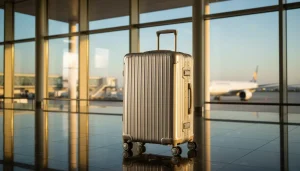
My mission is simple: to help you get a little baggage that is a trusted companion, not a time waster. This book is the result of hands-on experience. It’s for the business traveller who respects his time and for the holidaymaker who wants to start his holiday in a relaxed state.
My Methodology: How I Tested Gear
I rely on evidence rather than intuition. My testing schedule replicated decades of travel in a span of weeks, with the most directly applicable variables of your travel experience at the forefront.
To create a truly authoritative best travel luggage guide, I built a solid test regimen. Each was filled to the weight limit with an approved combination of weights and oversize loads. I rolled them miles along a mixed-terrain course of smooth tile (airports), low-pile carpet (hotels), and deliberately cracked pavement (city streets). I listened intently for wheel noise, handle shake, and general stability.
For durability, I subjected them to controlled abrasion testing and zipper stress testing. For usability, I put pocket placement logic and daily usage of compression systems through their paces. Top models weren’t just durable; they were also well-designed to make packing and living out of them easier.
The Workhorse: Travelpro Platinum Elite Expandable Carry-On
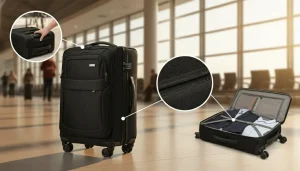
With all my stress testing, this model consistently emerged as the winner. It is a near-ideal mix of stability, smooth performance, and thoughtful features and a cornerstone of any best travel luggage guide.
The best here is its manoeuvrability. PrecisionGlide wheel system is silently fabulous and responsive, so a finger press will have you in the terminal masses. High-density nylon material, and I passed my scuff and scrape tests with flying colours. Under the hood, too, it’s fantastic. The integral suiter is the best I’ve ever used at making a jacket or dress look respectable, and the compression straps are secure and easy to use.
Is it perfect? Not the lightest in the world. But I believe that tiny extra weight is a worthwhile compromise for the stronger build and feeling of security that it offers. For the typical business traveller or for anyone most concerned with reliability, this is the best choice.
The Budget Champion: Amazon Basics 21-Inch Hardside Spinner
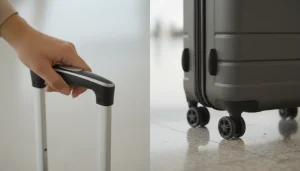
For the recreational flyer who’s strapped for cash, this is the best performance without breaking the bank. It’s a key inclusion in this best travel luggage guide for value. The polycarbonate shell was robust enough in my crash tests to withstand cracking and deep scratching. Spinner wheels rolled easily on hard floors.
The biggest concession is in the build. The telescoping handle had greater side play than on upscale versions and wasn’t as rigid when extended to full length. Linings on the inside are less decadent, either. But as a no-frills, low-cost option for a couple of trips a year, it’s an outstanding value and an amazing smart buy.
The Lightweight Specialist: Delsey Paris Helium Aero
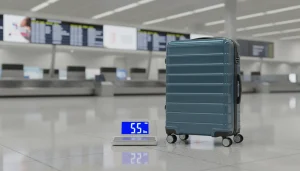
If you’re a master of packing light and always drift in and out of the airline weight limits, this model is your best bet. That’s why it earns a spot in this best travel luggage guide. It weighs only 5.5 pounds and makes the most of your packing room. It has a style-conscious appearance and double-spinner wheels that glide nicely.
The payoff for this lightness is structural stiffness. The shell is softer to flex than the Travelpro or even a pricier hardside bag. It’s protective enough, but it doesn’t command the same level of confidence for checked travel. It’s great for the minimalist packer who relies mostly on overhead storage.
The Long-Term Investment: Briggs & Riley Baseline Expandable Large Spinner
When you need to inspect your goods, you need a fortress. That is what this model is. It is built not for some trips, but for ten years and more of use. No best travel luggage guide would be complete without it.
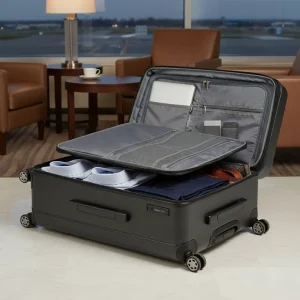
Its most innovative feature is the CX compression system. Unlike standard straps, this unit has a solid panel you press down, providing an incredible amount of added room and easily handling large objects. It’s revolutionary. The Makrolon polycarbonate case is top-notch, taking impacts without damage. And then there is the warranty—a quick, hassle-free “Simple as That” warranty that even includes airline damage. It’s unprecedented in the industry.
It is an expensive buy. But to a person always on the road on business, always travelling, or otherwise convinced of the value of paying once for quality, it’s an investment that pays many times daily in peace of mind and reliability.
The Dependable Player: Samsonite Winfield 2
One of the best of the tested competition, Winfield 2 mixes a robust shot of Samsonite’s highly regarded toughness with a lower price tag. It’s a reliable choice highlighted in this best travel luggage guide. Scratch-resistant hard shell and spinner wheels for durability bring it to the abusing traveller’s usual airport abuse.
It does not possess perhaps the best compression and bulletproof guarantee of Briggs & Riley, but it performs its main job adequately. It is a simple, quality option for the year-end family vacation or the traveller who does not demand the very best of the best amenities but wants quality instead.
The Adaptive All-Rounder: Peak Design Travel Backpack
This is not a backpack; this is a very elastic system. It wins hands down for the traveller whose trip may include a client presentation, a hike, and a long flight, all in one itinerary. It’s a unique but essential pick for a modern best travel luggage guide.
Its magic lies in its versatility. You can zip it up to a sleek 30L daypack or open it out to a maximum 45L travel pack. The entire interior is modulably configurable with dividers and pockets, and it’s perfect for photographers, digital nomads, or anyone with speciality gear. The weatherproof build is superb.
The worst drawback is weight. All that functionality comes from hardware and material built to last, so the pack weighs a lot even when in base weight config. It’s a compromise: unbeatable organisation at the cost of a higher base weight.
The Comfort-First Classic: Osprey Farpoint 40
A favourite among backpacking adventurers, the Farpoint 40 is designed with simplicity and comfort in mind. Its stowaway harness system and hip belt make it comfortable to wear for long periods of time, something the Peak Design cannot claim. It’s also considerably lighter.
The organisation is more straightforward, with a simple laptop sleeve and a few pockets. It’s designed for the traveller who packs efficiently and doesn’t need extensive internal customisation. For backpacking through Southeast Asia or a multi-city European tour where you’ll be carrying your pack for miles, this is often the more comfortable and pragmatic choice.
A Detailed Framework for Your Decision
Picking the right bags is more about discovering the product that best suits your personal travelling behaviour. The following is a step-by-step guide on what should guide your choice. This framework is the final, crucial part of this best travel luggage guide.
Step 1: Take a Look at Your Travel Profile
Ask yourself the following questions:
- Frequency: How frequently do you travel – weekly, monthly, or intermittently?
- Duration: Are your trips 2-day excursions or 2-week journeys?
- Destination: Do you find yourself transiting from high-end international airports or hard-scrabble, cobblestone towns?
- Content: Do you send suits and business wear, technical gear, or casual apparel?
Your answers will inevitably direct you to a section: a hard-case carry-on for the frequent flier, a large checked bag for the transcontinental traveller, or a utilitarian backpack for the adventure-hiking trekker.
Step 2: Learn to Understand Core Design Decisions
Material Science: Softside vs. Hardshell
- Softside (Nylon/Polyester): Offers flexure (you can force it into a small area) and typically additional outside pockets for quick access. High-denier ballistic nylon is very tough and typically lighter in weight than an equally tough shell. The actual disadvantage is that it gives less protection to actually delicate material and is more water-prone.
- Hardshell (ABS/Polycarbonate): Provides a hard shell that’s impact-protecting and very water-resistant. Polycarbonate is more shock-absorbing and flexible, yet ABS is harder and may be more brittle. The largest disadvantage is non-flexibility—it cannot be overstuffed.
The Wheel Dilemma: Spinners vs. Rollaboards
- Two-Wheel Rollaboards: They are usually more stable over irregular terrain and frequently have a less complex, heavier-duty mechanism with fewer stress points of failure. The downside is that you pull and lift them, which may be less convenient in close quarters.
- Four-Wheel Spinners: These provide ultimate manoeuvrability in busy, smooth settings such as airports. They can be pulled sideways, spun round in a kind of circular direction when still, and glide along beside you. But on uneven surfaces, they can be less stable, and their complex mechanisms are more susceptible to damage.
Step 3: Scrutinise the Details
- Handles: A loose handle is a perpetual irritation. Opt for strong, multi-stage locking mechanisms with good grip padding.
- Zippers: Heavy-duty, big YKK zippers are the default for longevity right from the beginning. Ensure that they slide smoothly even when the case is packed to the brim.
- Locks: TSA-approved locks provided are a luxury indulgence on flights between America and elsewhere, so security does not need to render your lock useless by opening up your bag.
Proactive Care and Maintenance
An excellent bag can easily last for dozens of years with good care and maintenance. These are my recommendations:
- Clean Often: Wipe clean hard shells with a damp cloth. Vacuum the interior and spot clean the exterior of softside materials using a mild soap solution.
- Check for Damage: Regularly check after each use. Look for loose stitching, debris in the wheel bearings, and dents or cracks in the shell. Early small problems prevent big breakdowns.
- Store Correctly: Drain your bags and store them in a dry, cool place, ideally stored in a cloth carrying bag. Never store it compressed or loaded down.
Honesty is transparency. Read why other number-one selling models weren’t selected.
- Away Carry-On: Sleek and featuring an easily detachable battery (a welcome touch), the handle of my test unit developed a distracting and uncomfortable shimmy when loaded, which my winner did not.
- Monos Checked Case: Sleek minimalist design, but its internal compression system employed only straps, which less successfully addressed bulging, irregularly shaped items than the panel-based system of the Briggs & Riley.
Answering Common Traveller Questions
Which is better in the long run?
Based on my evaluation of materials, construction, and most importantly, warranty conditions, Briggs & Riley and Travelpro are in a league of their own. Both firms have long-term customer service incorporated into their product policy.
Do I require a roller bag or a backpack?
Let your calendar be the judge. For easy mobility in big airports and smooth city roads, a roller bag is ideal. For journeys with bumpy roads, public conveyances, or several transports when your hands will be useful, a backpack is the only logical choice.
Is good-quality luggage’s high price worth it?
For the regular user, certainly. The additional initial cost gets you higher quality materials that won’t buckle, engineering that keeps the physical stress minimal (e.g., reinforced handle and wheels), and warranties which eliminate replacement cost down the line. It is a worthwhile investment in hassle-free travel. For the infrequent traveller, a middle-of-the-line model from a well-known company such as Samsonite or Delsey is a perfectly sensible choice.
Final Recommendations: Gear Synchronization to the Traveler
Following such a detailed analysis, my final recommendation is to choose based on the type of traveller you are.
- For the Frequent Business Traveller: The Travelpro Platinum Elite Carry-On is your unbeatable workhorse. Its ruggedness, business-casual look, and organisational features cannot be matched for the weekly routine.
- For The Long-Haul Vacationer or Relocator: The Briggs & Riley Baseline Expandable Spinner is worth every dollar spent. Its space, protective housing, and revolutionary warranty provide total peace of mind for long travel.
- For The Adaptive Adventurer: The Peak Design Travel Backpack is a toolbox for complex trips. Its adjustable design and hard-constructed build prepare you for everything from a coffee shop meeting to a mountain trail.
Your luggage selection is one of the best travel choices you’ll ever make. Focusing on proven performance and a responsive understanding of your own needs, you can select a companion that serves not only to haul your gear but also enhances your entire experience. Be smart with your money, and travel with confidence.